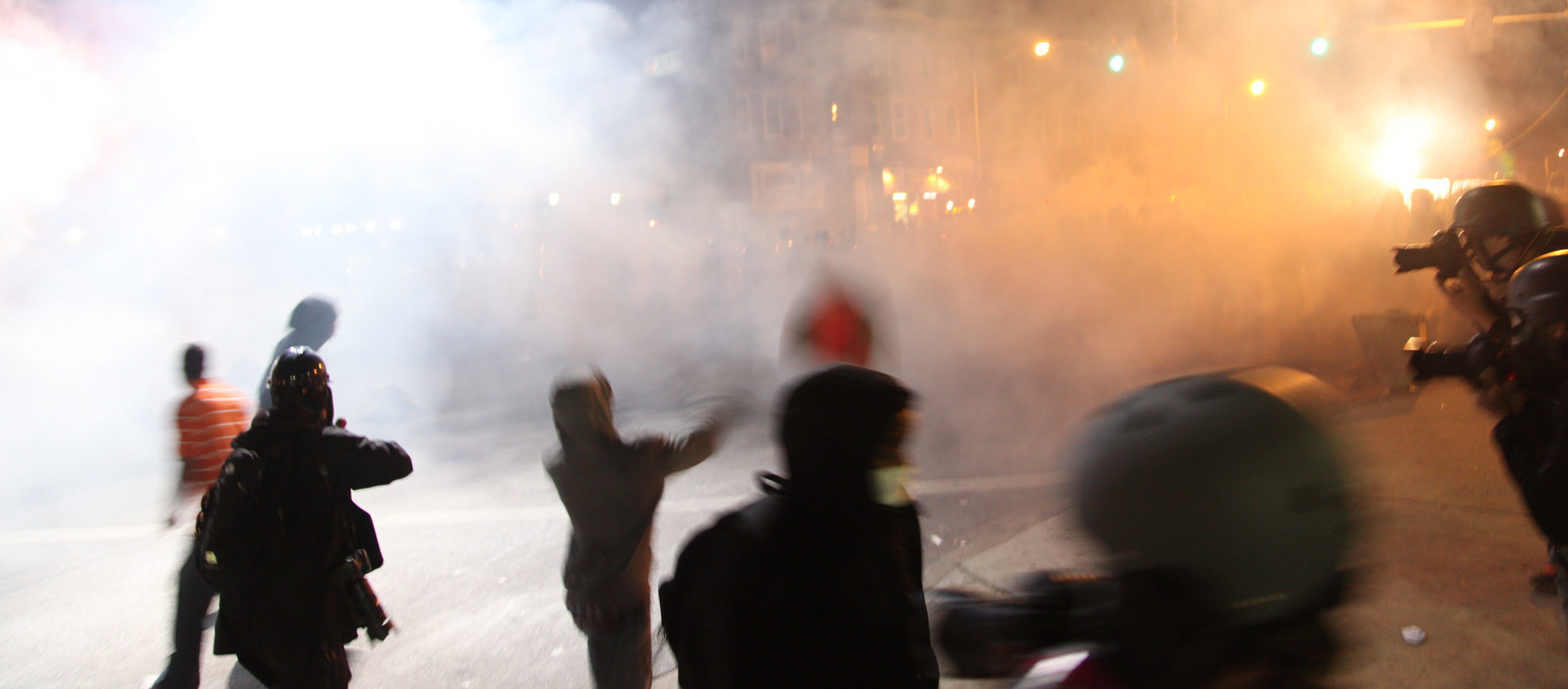Sign up for the daily CJR newsletter.
IN THE SEGREGATED CITY OF BALTIMORE, residents typically spend their time in either the “White L” or the “Black Butterfly”—the narrow corridor that runs through central Baltimore and along the Inner Harbor, and the neighborhoods that spread to the east and west. But Baltimore Sun reporters Justin Fenton and Kevin Rector traverse their borders almost daily, covering cops and crime. Over the past four years, Fenton and Rector have witnessed the city’s daily churn of violent crime and periodic scandal transform into near epochal upheaval. USA Today recently anointed the city the most dangerous in America.
Violent crime has surged in Baltimore since 2014, and the death of Freddie Gray in police custody sparked unrest that convulsed the city for weeks. A federal investigation found in 2016 that Baltimore Police Department had regularly violated citizens’ rights. The following year, eight members of the police department’s once-elite Gun Trace Task Force pleaded guilty or were convicted of breathtaking levels of corruption that floored journalists, cops, and residents.
ICYMI: “When a journalist dies, such questions, while on everyone’s mind, are often asked in a whisper.”
Baltimore counted 343 homicide victims last year—a per capita record for the city. (The total tops that of New York, a city whose population is 13 times the size of Baltimore’s.) Those victims included a Baltimore homicide detective who was slated to testify against officers in the Task Force case the day after his death. The killing remains unsolved, and hangs over the department.
While Gray’s death and the ensuing unrest attracted national media coverage, such attention has not been consistent. Local outlets have provided periodic deep dives. The bulk of Gun Trace Task Force stories in The New York Times have been AP wire stories; many of The Washington Post’s stories on the same case were provided through a partnership with the Sun, most of them written by Fenton or Rector.
It’s an act of journalistic triage that, on its best days, lets them tell stories that push back on the indifference and fatalism they fear is encroaching on their city.
Indeed perhaps more than any other journalists, it’s fallen on these two reporters to make Baltimore’s mayhem their business.
“They are thorough, they are on the ground,” says Melissa Rothstein, spokeswoman for the Maryland Public Defender’s Office. “So when there’s new information to provide, they’re the most reliable source, both to find out information…and knowing that they’re going to use it properly.”
FENTON, 34, is now in his 14th year at the Sun and his 10th on the crime beat. There used to be an equilibrium to his reporting with Rector in Baltimore, he says—“just enough crime that there was an expectation that we would cover just about everything that was going on.”
These days, deciding which crimes to more deeply cover—and which victims to write about—is often simply a function of time as it is a deliberate decision to cover one incident or victim over another. At a rate of nearly a killing a day, Fenton and Rector’s task is a monumental one; they must pick which victims to profile and which to group together into shorter round-ups, which accusations against police to dig into and which to set aside for now. It’s an act of journalistic triage that, on its best days, lets them tell stories that push back on the indifference and fatalism they fear is encroaching on their city. Still, says Fenton, “We can’t get to everyone. We’re not obituary writers.”
Fenton and Rector are both Maryland natives, graduates of the University of Maryland and veterans of the school’s well-regarded student newspaper, The Diamondback. For each, The Baltimore Sun network of newspapers was his first job out of college: Rector had stints at The Catonsville Times and The Arbutus Times before eventually being “called up” to the Sun’s newsroom, and Fenton first worked in the Sun’s county bureaus.
Fenton had built a reputation as a dogged crime reporter by the time Rector joined him on the beat. In 2011, he published an award-winning series that exposed how the Baltimore Police Department had mishandled numerous sexual assault cases. In an interview with CJR, former Baltimore Police Commissioner Fred Bealefeld, who led the department from 2007 to 2012, calls Fenton’s story “an exceptional piece of work,” and one that “deserves far more credit for shining a light, albeit one that was not favorable to BPD.” Bealefield and former State’s Attorney Gregg Bernstein characterize Fenton in the same way, independent of each other: “Justin is a pain in the ass.” Both mean it as a compliment.
Rector, 32, got tapped to take on cops and crime after pitching in with coverage of the Gray case and its aftermath—work that was later named a finalist for the Pulitzer Prize in Breaking News Reporting, for “fast-moving coverage … reflecting the newsroom’s knowledge of the community and advancing the conversation about police violence.” The new beat, says Rector, was a dream assignment.
“It impacts the economy, it impacts the schools, it impacts whether or not people want to live here in the city, and that subsequently impacts the taxes and the tax base and how the city functions,” Rector says. “Crime is the central issue for a lot of the politics in town. You can’t live in Baltimore and not be interested in crime.”
There is a moment where you look back on things you’ve heard from members of the public…and you look at what the Gun Trace Task Force did, and you think, ‘My God how deep does this go?’
CRIME USED TO OCCUPY MORE of Fenton and Rector’s time than cops. As crime on the streets spiked, however, so did public awareness of misconduct within the Baltimore Police Department, all of it demanding coverage.
“The last couple years have been like the previous seven, just on steroids,” Fenton says. “Everything is amplified. The corruption stories are much worse. The violence is much worse. The dysfunction in general is much worse.”
Even if Rector and Fenton generally manage to keep their work weeks to five days, the hours can be punishing. Rector, who married his boyfriend February 23, a Friday, was back in the newsroom that Tuesday. On any given Saturday or Sunday, Fenton—who has a wife and a young child at home—can be spotted at a crime scene.
“If I’m worried the paper’s not going to have the staff, I’ll go out and cover,” says Fenton, who admits that decision can be hard on his family. “Someone needs to be there.”
Even in low-crime cities, the beat—with its drumbeat of violence, family trauma, and anxiety over knocking on a grief-stricken person’s door—takes a toll. Rector says he avoids thinking too deeply about it.
“Like a lot of people—shock trauma surgeons and nurses and police officers, whoever else—you do tend to compartmentalize it to some degree,” Rector says. “It is to some extent cathartic to write the stories that I’m witnessing. It’s cathartic to get them out of me and onto paper and share them with other people.”
Fenton, too, says he tries “not to get caught up.” But he also recounted driving through West Baltimore on a day in 2015 and seeing a procession of some 150 people walking through the city, led by a pastor who carried a giant cross.
“I became emotional,” Fenton says. “I remember getting out and walking up to them, and they gave me a little card—I still have it in my car.” It remains a reminder, he says, that there are people still involved and invested in Baltimore.
FENTON AND RECTOR SAY they always brought skepticism to their work, but were perhaps less wary of official police narratives than they should have been. Recent events have made them more reflective. In the wake of Gray’s death, the acquittals and dropped charges for officers involved in Gray’s arrest, the Justice Department investigation and subsequent consent decree, and the Gun Trace Task Force case, residents’ accusations of police misconduct have taken on new significance, and rumors have become to seem more plausible.
“There is a moment where you look back on things you’ve heard from members of the public, really atrocious things that you couldn’t quite prove or weren’t quite sure if they were accurate, and you look at what the Gun Trace Task Force did, and you think, ‘My God how deep does this go?’” Rector says. “All of these things reshape how you see the police department.”
It’s a change that some readers say they’ve observed, too—particularly in Fenton.
“You look at his coverage four years ago before the protests started, and there were two sides to things,” says DeRay McKesson, a prominent civil rights activist in Baltimore. “Now it’s like, ‘This just doesn’t make sense,’ and really being a more curious thinker about challenging narratives from the government.”
Mayor Catherine Pugh, a Democrat, has recently pushed back on what she calls “the narrative,” urging supporters to “challenge the media” to focus more on positive stories and less on crime. Rector and Fenton, however, both say they’re more resolved than ever, galvanized by the recent revelations of just how far their city needs to come.
“I write the story and I tell people what happened, and I hope that my story gets people to sit up in their seats and think about what’s going on in Baltimore,” Rector says. As for official narratives from the mayor and the police commissioner, he continues, “I don’t let them tell me everything’s fine and the narrative should be better and ‘Isn’t Baltimore’s Inner Harbor beautiful?’ Yeah, it is, but this happened today, too. You know what I saw today? What are you doing about that?”
ICYMI: An acclaimed crime reporter leaves her newsroom for police work
Has America ever needed a media defender more than now? Help us by joining CJR today.







